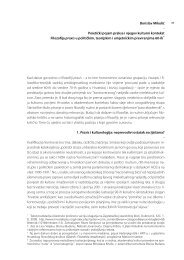Freud's Self-Analysis—An Interpersonally Grounded Process
Freud's Self-Analysis—An Interpersonally Grounded Process
Freud's Self-Analysis—An Interpersonally Grounded Process
You also want an ePaper? Increase the reach of your titles
YUMPU automatically turns print PDFs into web optimized ePapers that Google loves.
82 M Conci Int Forum Psychoanal 7, 1998<br />
passage of his letter from Freiberg of September 4<br />
1872) and to thus eventually court Martha, through<br />
his relationship with her he could eventually abreact<br />
all the pain and sorrow he had accumulated up to<br />
then—to the point of expressing the feeling of never<br />
having been young.<br />
As a matter of fact, if we take into careful consideration<br />
the first paragraph of this same letter, we<br />
can conceive a further interesting hypothesis. Let us<br />
listen to Freud again:<br />
My beloved sweet darling, you write so charmingly and<br />
sensibly that every time you speak your mind about<br />
something I feel soothed. I don’t know how to thank<br />
you; I have recently decided to show you a special kind<br />
of consideration (you will laugh): by making up my mind<br />
not to be ill. For my tiredness is a sort of minor illness;<br />
neurasthenia, it is called; produced by the toils, the worries<br />
and excitements of these last years, and whenever I have<br />
been with you it has always left me as though touched by a<br />
magic wand. So I must aim at being with you very soon<br />
and for a long time...(1:200).<br />
Now let us listen to how Jones presented Freud’s and<br />
Breuer’s 1895 Studies on Hysteria: ‘‘In the Studies<br />
on Hysteria the authors insisted that mere recollection<br />
without affective abreaction is of little therapeutic<br />
value’’ (8:178). My hypothesis is that before<br />
utilizing the instrument of catharsis with his own<br />
patients, Freud had successfully experienced it at the<br />
hands of Martha. Of course, I am not oblivious of the<br />
fact that any significant love relationship brings about<br />
important psychological changes in the two partners;<br />
all I want to show is the necessity of first patiently<br />
looking into Freud’s life, if we really are to understand<br />
his work. By this I also mean to imply that<br />
Freud’s case cannot be different from ours: inasmuch<br />
as for most of us the experience of some change in<br />
our life was the precondition for us to choose to<br />
embark on an analytic experience, this must have also<br />
been true of Freud. He must have first experienced<br />
some change in his life before trying to devise an<br />
instrument which would allow him to help his<br />
patients move in the same direction. As we were<br />
taught in medical school, medicine is the amplification<br />
of nature’s healing properties; I believe this to be<br />
true also of psychoanalysis. Eissler too comes to the<br />
point of speaking of Freud’s relationship with Martha<br />
in terms of ‘‘a structural change’’ (15:492), the<br />
premises of which had been laid by the ‘‘silent<br />
maturation’’ (15:490) he had achieved going through<br />
medical school.<br />
Indeed, Jones repeatedly hints at Freud’s hysteria,<br />
but he never puts it in direct connection with his<br />
work. Here is an example: ‘‘He inferred, from the<br />
existence of some hysterical symptoms in his brother<br />
and several sisters (not himself: nota bene), that even<br />
his own father had to be incriminated ... ‘‘ (8:211). In<br />
my opinion, we would gain much from rereading<br />
Freud’s preanalytic writings and letters trying to<br />
figure out how his own attempts at self-cure influenced<br />
the development of his ideas—as opposed<br />
to merely reconstructing the theoretical path he<br />
followed, as Ola Andersson did in 1962 (24) or<br />
Georg Reicheneder in 1990 (25). A fascinating<br />
excursion in this direction is contained in Helmut<br />
Junker’s 1991 book Von Freud in den Freudianern<br />
(26), in which he contributes important clues to the<br />
construction of Freud’s ‘‘clinical history’’.<br />
Conclusion<br />
After a very detailed consideration of Freud’s adolescence,<br />
Eissler could not avoid the conclusion that<br />
also in his case ‘‘adolescence is the fountainhead of<br />
all later creativity’’ (15:514). I might not be right in<br />
my opinion about what Freud himself called ‘‘the<br />
development of the hero’’, but I am sure I have not<br />
gone astray by proposing to bridge the gap between<br />
his personal development and his development of<br />
psychoanalysis. His own self-analysis can not have<br />
been a ready-made instrument, but was probably<br />
something he developed in the course of a much<br />
longer period of time than merely the Fliess period. In<br />
a short essay composed in 1920, ‘‘A note on the<br />
prehistory of psychoanalytic technique’’ (27), he<br />
himself retraced to his adolescence the roots of the<br />
concept of free association. Originally published<br />
anonymously, the 1920 note retraces the concept of<br />
free-association to Ludwig Boerne’s 1823 essay<br />
‘‘The art of becoming an original writer in three<br />
days’’, which ends up being redefined in terms of<br />
‘‘the fragment of cryptomnesia which in so many<br />
cases may be suspected to lie behind apparent originality’’<br />
(27:265).<br />
As far as the interpersonal sources are concerned, I<br />
would like to point out how Freud himself did not<br />
disregard an outlook such as the one later developed<br />
by Sullivan. The crucial role of the interpersonal<br />
factor clearly stands out in his 1914 short essay ‘‘A<br />
note on schoolboy psychology’’:<br />
My emotion at meeting my old schoolmasters warns me to<br />
make a first admission: it is hard to decide whether what




